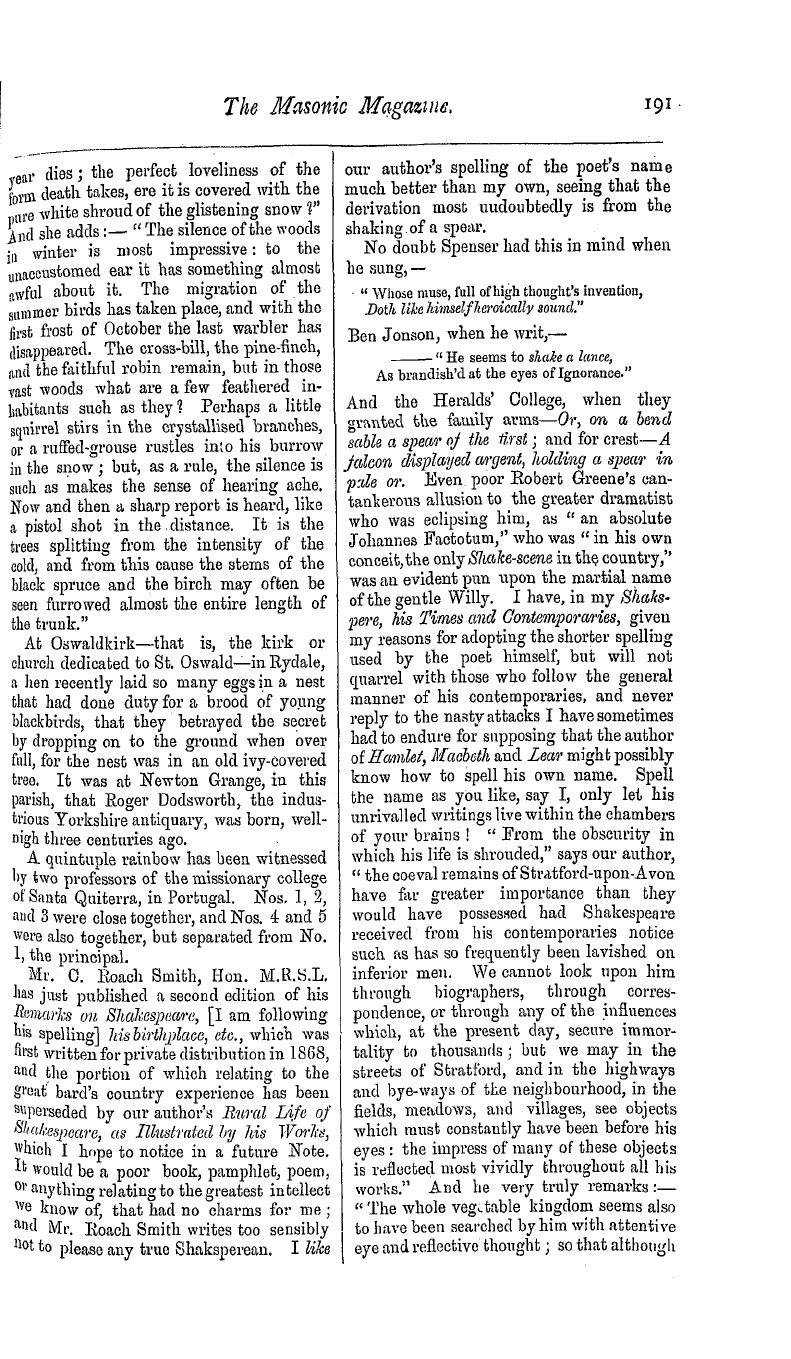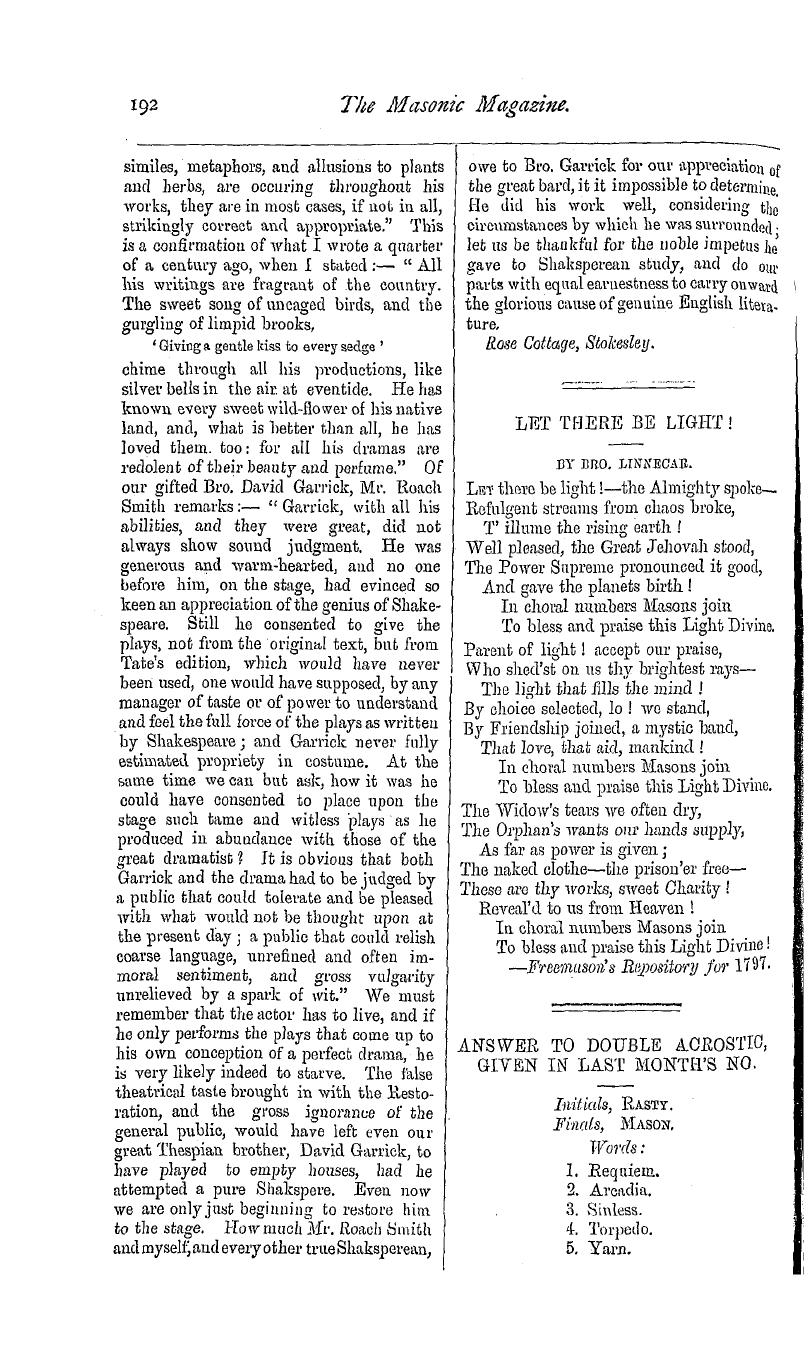-
Articles/Ads
Article THE MASONIC LANGUAGE OF FLOWERS. ← Page 2 of 3 →
Note: This text has been automatically extracted via Optical Character Recognition (OCR) software.
The Masonic Language Of Flowers.
lotus , which they call the "fruit of destiny , " and say it is to be eaten in Paradise . In this connection the reader wiU recall Tennyson ' s exquisite poem of the " Lotus-Eaters . " Hindostan appears to have been the
birth-p lace of the Lotus , and the Sanscrit hymns and legends are full of it . From India it , with its mystic character , was transp lanted to Egypt . No plant exceeded it in sacredness . The Egyptian priest fathered it with the most solemn ceremonies
, and bound it around the altars , and the virgin priestesses wore it in their hair . It was the Lily of the Nile , the Rose of Egypt . In its consecrated bosom Brahma was born , and on it Osiris delighted to float . Among the Chinese it symbolized female beauty ,
and they call the small feet of their women " golden lilies . " Mysteriously floating upon the water , it represented to the ancients that " Spirit of God" which the hook of Genesis , in the Great Light of Masonry , informs us " moved upon the face of the waters " at the Creation . We do
well to contemplate this floral gem of the East , this choicest flower that decks the land of the Sun . Cusa Grass , next to the Lotus , has a mystic significance . It , too , is of Indian origin , having had its earliest home in Hindostan . Its long tapering leaves were
symbolical of acuteness of intellect , and its blood-red flowers were used in the priestly sacrifices . According to Sir William Jones it derived its name , Cusa , or Cusha from Gush , the father of the Hindoo race . The Oushites , or Ethiopians , under the name of
Shepherds , afterward invaded and ruled % ypt for some generations . It was an Indian custom to bite a blade pf the Cusa grass in token of submission , and it Was also used in the preparation of the candidate for the sacred mysteries , to enable aim to
rightly pronounce the holy word . As among the Jews , so in India , this holy A ™ rd was never pronounced aloud , but always inwardly or inaudibly , and only per the strictest vigils . We are reminded ' b Y this of the Lost Word of Freemasonry , ? < 1 of its substitute in the Blue Lodge , and V recov ery by the companions of the Royal
According to the Menu , one of the sacred rooks of Hindostan , " if one has sat on cushions of Cusa , with their points toward
the east , and is purified by rubbing that holy grass in both hands , and be further prepared by three suppressions of the breath , he may then fitly pronounce Om . " This word was the original of the Egyptian word Ou , the sun . From the Egyptian mystics it has descended to the Royal
Craft of to-day . An Indian legend relates that Cupid was bound to his bride with a wisp of the sacred Cusa grass , and that the priest who united them had his vestments fashioned out of its
leaves arranged m triple cords . The Myrtle tree is sacred both in Scripture and mythology . In Zachariah's famous vision , he beheld a horsemen riding among the myrtle trees ; and in Isaiah ' s prophecy , in the last days we learn that instead of the briar shall come up the
myrtle tree , when peace and universal joy shall fill the earth . Hence the myrtle is an emblem of peace , and in mythology , also of love and beauty . The first temple erected to Venus was surrounded hy a grove of myrtles .
The Rose , from the beginning of the world , has been a symbolical flower . It has always been the emblem of the highest good and the chiefest beauty . Poets have sung its virtues endlessly . Among the Egyptians it was an emblem of silence , and this is its Masonic signification . We find it chiseled often by the operative Masons of the Middle Ages upon the walls
of the gieat abbeys and cathedrals which they erected . Fort , in his " Antiquities of Masonry , " traces the phrase " sub rosa " to a Masonic origin . He says : " At the feasts of the Northern people , a garland of flowers , with a rose prominently in the centrewas suspended from the ceiling
, above the table , as a symbol that everything that might be done or spoken by the participants in the banquet should be held strictly secret . " In the Gothic code , the rose was an emblem of secrecy , and was so considered by the medieval
Operative Masons . The Clover , humble though it be , from the remotest antiquity has been revered . Its triple leaf Was considered symbolical . In Ireland , St . Patrick chose it as an emblem of the Trinity , and the famous shamrock of Ireland is only the ordinary white clover . Hope was personfied , in ancient times , by a little child standing on tiptoe
Note: This text has been automatically extracted via Optical Character Recognition (OCR) software.
The Masonic Language Of Flowers.
lotus , which they call the "fruit of destiny , " and say it is to be eaten in Paradise . In this connection the reader wiU recall Tennyson ' s exquisite poem of the " Lotus-Eaters . " Hindostan appears to have been the
birth-p lace of the Lotus , and the Sanscrit hymns and legends are full of it . From India it , with its mystic character , was transp lanted to Egypt . No plant exceeded it in sacredness . The Egyptian priest fathered it with the most solemn ceremonies
, and bound it around the altars , and the virgin priestesses wore it in their hair . It was the Lily of the Nile , the Rose of Egypt . In its consecrated bosom Brahma was born , and on it Osiris delighted to float . Among the Chinese it symbolized female beauty ,
and they call the small feet of their women " golden lilies . " Mysteriously floating upon the water , it represented to the ancients that " Spirit of God" which the hook of Genesis , in the Great Light of Masonry , informs us " moved upon the face of the waters " at the Creation . We do
well to contemplate this floral gem of the East , this choicest flower that decks the land of the Sun . Cusa Grass , next to the Lotus , has a mystic significance . It , too , is of Indian origin , having had its earliest home in Hindostan . Its long tapering leaves were
symbolical of acuteness of intellect , and its blood-red flowers were used in the priestly sacrifices . According to Sir William Jones it derived its name , Cusa , or Cusha from Gush , the father of the Hindoo race . The Oushites , or Ethiopians , under the name of
Shepherds , afterward invaded and ruled % ypt for some generations . It was an Indian custom to bite a blade pf the Cusa grass in token of submission , and it Was also used in the preparation of the candidate for the sacred mysteries , to enable aim to
rightly pronounce the holy word . As among the Jews , so in India , this holy A ™ rd was never pronounced aloud , but always inwardly or inaudibly , and only per the strictest vigils . We are reminded ' b Y this of the Lost Word of Freemasonry , ? < 1 of its substitute in the Blue Lodge , and V recov ery by the companions of the Royal
According to the Menu , one of the sacred rooks of Hindostan , " if one has sat on cushions of Cusa , with their points toward
the east , and is purified by rubbing that holy grass in both hands , and be further prepared by three suppressions of the breath , he may then fitly pronounce Om . " This word was the original of the Egyptian word Ou , the sun . From the Egyptian mystics it has descended to the Royal
Craft of to-day . An Indian legend relates that Cupid was bound to his bride with a wisp of the sacred Cusa grass , and that the priest who united them had his vestments fashioned out of its
leaves arranged m triple cords . The Myrtle tree is sacred both in Scripture and mythology . In Zachariah's famous vision , he beheld a horsemen riding among the myrtle trees ; and in Isaiah ' s prophecy , in the last days we learn that instead of the briar shall come up the
myrtle tree , when peace and universal joy shall fill the earth . Hence the myrtle is an emblem of peace , and in mythology , also of love and beauty . The first temple erected to Venus was surrounded hy a grove of myrtles .
The Rose , from the beginning of the world , has been a symbolical flower . It has always been the emblem of the highest good and the chiefest beauty . Poets have sung its virtues endlessly . Among the Egyptians it was an emblem of silence , and this is its Masonic signification . We find it chiseled often by the operative Masons of the Middle Ages upon the walls
of the gieat abbeys and cathedrals which they erected . Fort , in his " Antiquities of Masonry , " traces the phrase " sub rosa " to a Masonic origin . He says : " At the feasts of the Northern people , a garland of flowers , with a rose prominently in the centrewas suspended from the ceiling
, above the table , as a symbol that everything that might be done or spoken by the participants in the banquet should be held strictly secret . " In the Gothic code , the rose was an emblem of secrecy , and was so considered by the medieval
Operative Masons . The Clover , humble though it be , from the remotest antiquity has been revered . Its triple leaf Was considered symbolical . In Ireland , St . Patrick chose it as an emblem of the Trinity , and the famous shamrock of Ireland is only the ordinary white clover . Hope was personfied , in ancient times , by a little child standing on tiptoe
















































